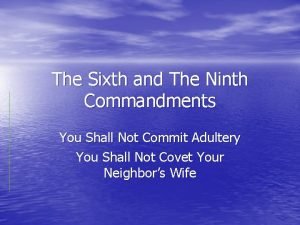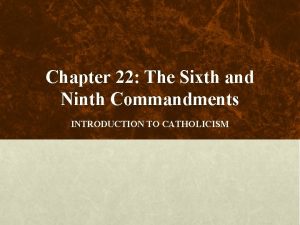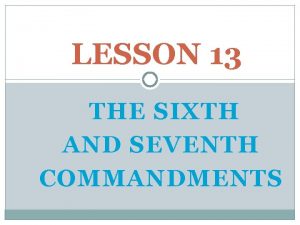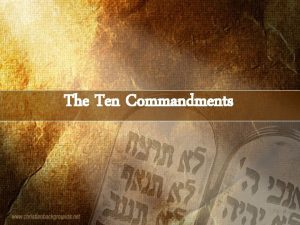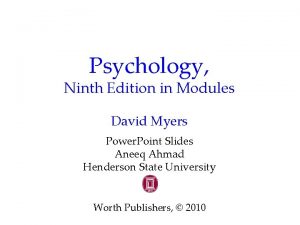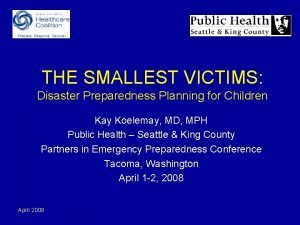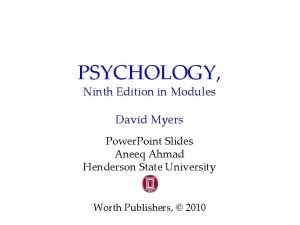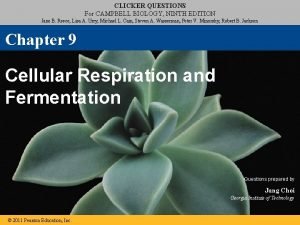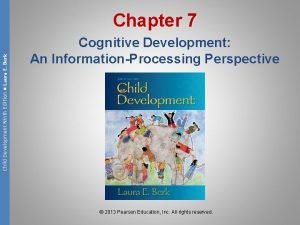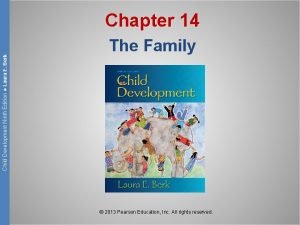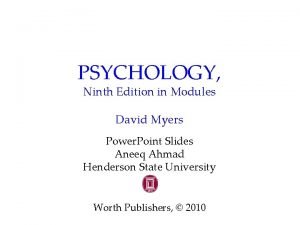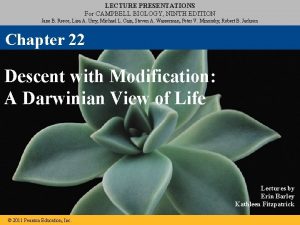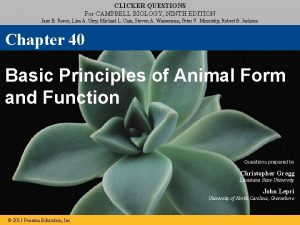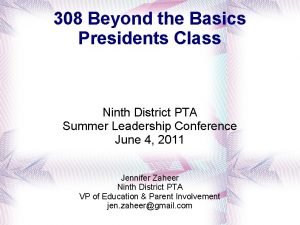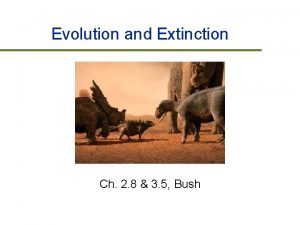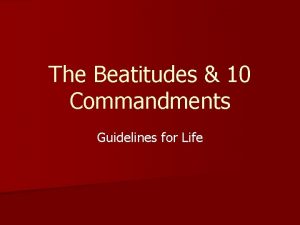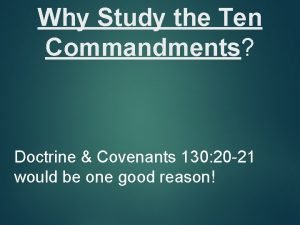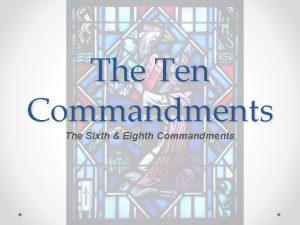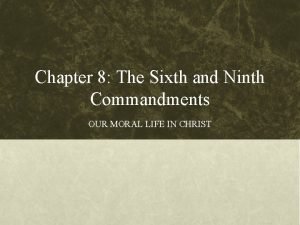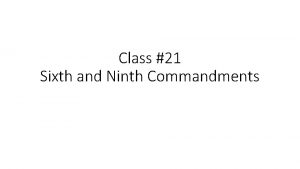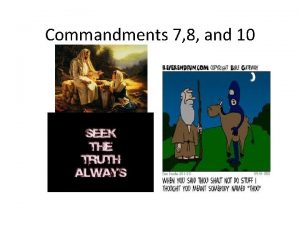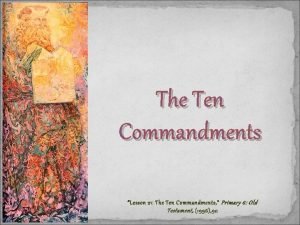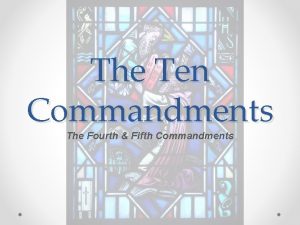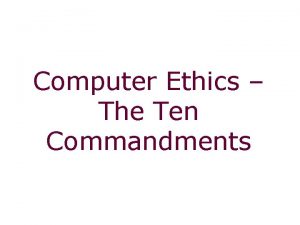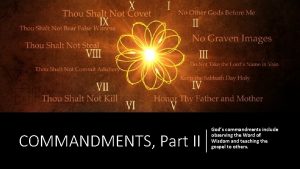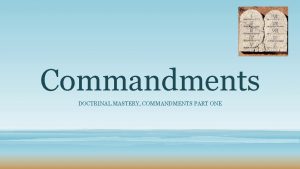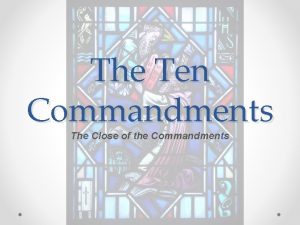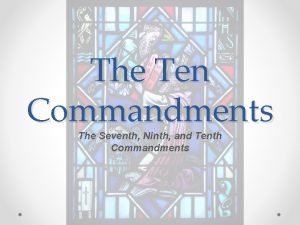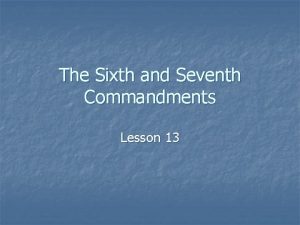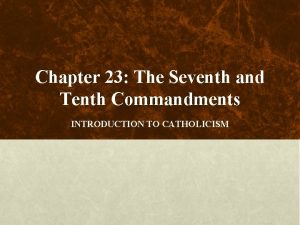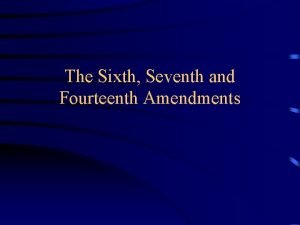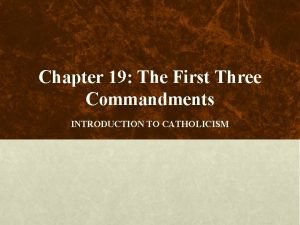Chapter 22 The Sixth and Ninth Commandments INTRODUCTION







































































- Slides: 71

Chapter 22: The Sixth and Ninth Commandments INTRODUCTION TO CATHOLICISM

1. The Sixth and Ninth Commandments in Sacred Scripture (pp. 496 -499) ANTICIPATORY SET Free write for a few minutes about what the story of the creation of Eve (cf. Gn 2: 18 -25) reveals about the nature of marriage.

1. The Sixth and Ninth Commandments in Sacred Scripture (pp. 496 -499) BASIC QUESTIONS What is the meaning of the Sixth and Ninth Commandments in Sacred Scripture? What is marriage? KEY IDEAS The Sixth and Ninth Commandments specifically prohibit extramarital sex in deed and thought and articulate the full meaning of the gift of human sexuality and its proper expression. Marriage, a creation of God, is an exclusive lifelong union of a man and woman, which is open to procreation.

1. The Sixth and Ninth Commandments in Sacred Scripture (pp. 496 -499) FOCUS QUESTIONS How did God create human beings as sexual creatures? God created man and woman with natural sexual differences and a strong, mutual sexual attraction. In what state did God create Adam and Eve? He created them in the state of marriage as husband wife. What does the term “one flesh” mean? It refers to the sexual union that is properly expressed only in marriage.

1. The Sixth and Ninth Commandments in Sacred Scripture (pp. 496 -499) FOCUS QUESTIONS What does it mean to say that marriage is a divine institution from the beginning of time? At Creation God established marriage as the means to unite a man and a woman. What does it mean to say that husband wife are complementary? Their sexual relations and their social, familial roles are different but fit together to form a unified whole. Each has strengths and traits that help and complete the other.

1. The Sixth and Ninth Commandments in Sacred Scripture (pp. 496 -499) FOCUS QUESTIONS What effect did Original Sin have on the meaning and purpose of marriage and sexuality? After the Fall, the human body became a temptation for self-seeking pleasure rather than self-giving love. Man and woman could now view each other’s body apart from the soul, thus obscuring the other person’s unique human dignity. How is polygamy seen in the Old Testament? It was tolerated.

1. The Sixth and Ninth Commandments in Sacred Scripture (pp. 496 -499) FOCUS QUESTIONS Why did the prophets sometimes refer to Israel as a harlot? They did so because of her infidelity to God, who played the role of Israel’s faithful and aggrieved husband. What conclusion can be drawn about infidelity in marriage from the analogy of Israel as harlot? Just as it was wrong for the nation of Israel to be unfaithful to her covenant with God, it is wrong for a husband or wife to be unfaithful to the other in their marriage covenant.

1. The Sixth and Ninth Commandments in Sacred Scripture (pp. 496 -499) GUIDED EXERCISE The section “The Sixth and Ninth Commandments in the Old Testament” (pp. 498 -499) lists six important teachings about marriage and sexuality drawn from the first three chapters of the Book of Genesis. Work with a partner to choose two of these teachings, find their origin in the Book of Genesis, cite it (chapter and verse[s]), and comment on the connection between the biblical source and theological conclusion.

1. The Sixth and Ninth Commandments in Sacred Scripture (pp. 496 -499) FOCUS QUESTIONS What is the fundamental meaning of the Sixth and Ninth Commandments? The Sixth Commandment declares that a person must not have sexual relations with anyone except his or her spouse. The Ninth Commandment declares that a person must not even desire to violate the Sixth Commandment. What is the meaning of the Sixth and Ninth Commandments in their fullness? These Commandments articulate the authentic nature of human sexuality, the proper expression of the gift of human sexuality, and respect for the state of marriage.

1. The Sixth and Ninth Commandments in Sacred Scripture (pp. 496 -499) FOCUS QUESTIONS What does it mean to covet another person? It means to have an inordinate, immodest, or inappropriate desire for someone over whom one has no right or privilege. It is entertaining of desire, particularly sexual desire, for someone other than one’s own spouse. Extension: Coveting is not an instinctual urge or spontaneous emotion, although it has its origin in these passions; it is rather a decision of the will. What is the only “place” that human sexuality can find its true meaning and full expression? Human sexuality can find its true meaning and full expression only within Christian marriage.

1. The Sixth and Ninth Commandments in Sacred Scripture (pp. 496 -499) FOCUS QUESTIONS What does it mean to say that marriage is exclusive and lifelong? Marriage is exclusive in that it is only between one man and one woman, and lifelong in that it lasts as long as they are both alive. How did Christ underline the exclusive and lifelong nature of marriage? Christ emphasized the exclusive and lifelong nature of marriage by prohibiting divorce. Referring to how from the beginning of creation husband wife became “one flesh, ” he declared that “‘What therefore God has joined together, let not man put asunder’” (Mk 10: 9).

1. The Sixth and Ninth Commandments in Sacred Scripture (pp. 496 -499) FOCUS QUESTIONS Why does marriage have both a spiritual and physical dimension? Marriage has both spiritual and physical dimensions, because the human person is both soul and body. What is the spiritual dimension of marriage? The spiritual dimension of marriage is the exclusive, lifelong, and selfgiving commitment of the spouses.

1. The Sixth and Ninth Commandments in Sacred Scripture (pp. 496 -499) FOCUS QUESTIONS What is the physical dimension of marriage? The physical dimension of marriage refers to the spouses’ sexual intimacy. How are the spiritual and physical dimensions of marriage related? The sexual union of the spouses is a visible, physical sign of their spiritual union. The sexual union expresses and reaffirms their spiritual union.

1. The Sixth and Ninth Commandments in Sacred Scripture (pp. 496 -499) GUIDED EXERCISE Perform a focused reading of Romans 1: 24 -27 (p. 499) using the following question: What is the origin of sexual sins, according to St. Paul?

1. The Sixth and Ninth Commandments in Sacred Scripture (pp. 496 -499) HOMEWORK ASSIGNMENT Study Questions 1, 3 (p. 516) Practical Exercise 2 (p. 517) Workbook Questions 1 -9 Read “Theology of the Body” through “Marriage Revisited” (pp. 500 -501)

1. The Sixth and Ninth Commandments in Sacred Scripture (pp. 496 -499) CLOSURE Write a paragraph summarizing the nature of marriage in Sacred Scripture.

1. The Sixth and Ninth Commandments in Sacred Scripture (pp. 496 -499) ALTERNATIVE ASSESSMENT Work with a partner to answer Practical Exercise 2 about advice to a worried young woman.

2. Theology of the Body and the Meaning of Marriage (pp. 500 -501) ANTICIPATORY SET Mini-lecture about Pope Bl. John Paul II’s personalist principle.

2. Theology of the Body and the Meaning of Marriage (pp. 500 -501) BASIC QUESTIONS What is theology of the body? What are the purposes of marriage? What are the properties of marriage? KEY IDEAS Pope Bl. John Paul II’s theology of the body is based on the principles that a person must always be loved for his or her own sake and never become an object to be used by others, the complementarity of man and woman, and marriage as a total gift of self. God created sexual intercourse with a twofold purpose: the loving union of husband wife and the procreation and education of children; both marriage and each marital act must be a total gift of self, open to children. Marriage also has the properties of being exclusive and lifelong.

2. Theology of the Body and the Meaning of Marriage (pp. 500 -501) GUIDED EXERCISE Think/Pair/Write/Share using the following question: If, according to the language of the body, sexual intercourse says, “I love you and give myself to you totally, ” why is premarital sexual intercourse a lie?

2. Theology of the Body and the Meaning of Marriage (pp. 500 -501) GUIDED EXERCISE Work with a partner to come up with bullet points articulating the full meaning of “conception” based on the paragraph beginning, “Likewise, the conjugal act…” (p. 501) including the excerpt from Gaudium et Spes.

2. Theology of the Body and the Meaning of Marriage (pp. 500 -501) FOCUS QUESTIONS What are the two purposes of the marital act? The two purposes of the marital act are unity and procreation. What is the meaning of the unitive purpose of the marriage act? The term unitive means that the marital act must be an expression of self-giving love between a validly married husband wife, who are committed to their exclusive, lifelong union.

2. Theology of the Body and the Meaning of Marriage (pp. 500 -501) FOCUS QUESTIONS What is the meaning of the procreative purpose of the marriage act? The term procreative means that every sexual act must be open to the possibility of conception. What is the exclusive property of marriage? Marriage is exclusive in that it does not admit of third parties: a person cannot give himself or herself totally to more than one person in the same way.

2. Theology of the Body and the Meaning of Marriage (pp. 500 -501) FOCUS QUESTIONS What is the indissoluble property of marriage? Marriage is indissoluble in that it cannot be ended while both spouses are living. Does every human sexual act have to be an expression of total love and open to life in order to be morally good? Yes.

2. Theology of the Body and the Meaning of Marriage (pp. 500 -501) FOCUS QUESTIONS What truth is at the basis of Pope John Paul II’s theology of the body? The truth at the basis of Pope John Paul II’s theology of the body is that a person must always be loved for his or her own sake and never become an object to be used by others. For John Paul II, what is the meaning of communio personarum in light of man as the image of God? Man is made in the image of God, not only as an individual but also as the community of persons formed in marriage and the family. The community of persons in the family is an image of the community of the Father, Son, and Holy Spirit in the Blessed Trinity.

2. Theology of the Body and the Meaning of Marriage (pp. 500 -501) FOCUS QUESTIONS According to John Paul II, what does God want the marital act to express? The marital act, according to John Paul II, must express the spouses’ total gift of self to one another. What is meant by “total gift of self? ” By “total gift of self, ” John Paul II means the complete commitment of husband wife to love and serve each other for life, which is physically expressed by sexual intercourse.

2. Theology of the Body and the Meaning of Marriage (pp. 500 -501) FOCUS QUESTIONS What is the language of the body? It is the idea that our physical acts have a meaning, that they “say” something about us. What does the language of the body “say” in terms of the marital act? The marital act, by its nature, should “say” that the spouses totally give themselves to each other in love.

2. Theology of the Body and the Meaning of Marriage (pp. 500 -501) FOCUS QUESTIONS Is sexual pleasure sinful in itself? No. Sexual pleasure is created by God and is good in itself. When is sexual pleasure sinful? Sexual pleasure is morally disordered when sought for itself or isolated from its procreative and unitive purposes.

2. Theology of the Body and the Meaning of Marriage (pp. 500 -501) HOMEWORK ASSIGNMENT Study Question 2 (p. 516) Workbook Questions 10 -14 Read “Sins Against Marriage” through the sidebar “Natural Family Planning” (pp. 502 -506)

2. Theology of the Body and the Meaning of Marriage (pp. 500 -501) CLOSURE Write a paragraph summarizing the twofold purpose of marriage in light of Christian personalism.

2. Theology of the Body and the Meaning of Marriage (pp. 500 -501) ALTERNATIVE ASSESSMENT Free write for a few minutes about the basic principle of Christian personalism: everyone must love other persons and never use them as a means to an end. Consider the following questions in your answers: Is the personalist principle true? Do I want other people to treat me this way? Why or why not? Why am I tempted to treat others as means? How would my life be different if I were to live this principle to its full extent?

3. Sins Against Marriage and Natural Family Planning (pp. 502506) ANTICIPATORY SET Work with a partner to analyze what is wrong with the various practices outlined in Practical Exercise 1 based on the unitive and procreative purposes of marriage.

3. Sins Against Marriage and Natural Family Planning (pp. 502506) BASIC QUESTIONS What are sins against marriage? What is natural family planning? KEY IDEAS Grave sins against marriage include divorce, adultery, polygamy, incest, sexual abuse, cohabitation, contraception, artificial insemination, and in vitro fertilization. Natural family planning is an acceptable (licit) means of preventing pregnancy for a just reason by abstaining from the marriage act when conception could occur.

3. Sins Against Marriage and Natural Family Planning (pp. 502506) FOCUS QUESTIONS Why are certain sins categorized as against marriage? Sins against marriage violate the permanence of marriage, its exclusivity, or its unitive and procreative purposes, which are essential to marriage. What is the result of living the Church’s teachings on marriage and human sexuality? The result of fidelity to the Church’s teachings is a healthy and happy marriage. What is the result of a failure to live the Church’s teachings on marriage and human sexuality? Failure to live the Church’s teaching will likely result in untold problems for marriage, the family, and ultimately society itself.

3. Sins Against Marriage and Natural Family Planning (pp. 502506) FOCUS QUESTIONS What is divorce? Divorce is a civil dissolution of marriage. It is the breaking of the lifelong commitment of fidelity and spousal love vowed by the sacred bond of marriage, often done with the intent of marrying another person. According to the Catechism, no. 2384, what is the remarriage of a validly married person? It is a situation of public and permanent adultery.

3. Sins Against Marriage and Natural Family Planning (pp. 502506) FOCUS QUESTIONS To whom is divorce an injustice? Divorce can be an injustice to an innocent spouse, and it is always an injustice to the children. Are there situations in which a separation through a civil divorce may be necessary? Yes; in situations of abuse, abandonment, and adultery, the only protection for an innocent spouse and the children may be through a civil divorce. The divorced spouses, however, remain validly married.

3. Sins Against Marriage and Natural Family Planning (pp. 502506) FOCUS QUESTIONS What is adultery? Adultery is sexual relations between two people when one or both of them are married to other people. What is wrong with adultery? Adultery violates the true meaning of the conjugal act of total, self-giving love and betrays the exclusive marital commitment made before God. How can spouses guard against temptations to infidelity? Spouses should avoid both close relationships with members of the opposite sex and the temptation to think one is invulnerable to a fall.

3. Sins Against Marriage and Natural Family Planning (pp. 502506) FOCUS QUESTIONS Why is polygamy wrong? Polygamy violates the exclusive unity of marriage; a person can be married to only one other person at the same time. What is incest? Incest is sexual relations between close relatives.

3. Sins Against Marriage and Natural Family Planning (pp. 502506) FOCUS QUESTIONS What is sexual abuse? Sexual abuse is sexual relations between an adult and a minor. What is cohabitation? Cohabitation is living together in a sexual relationship before marriage or in rejection of the marriage commitment.

3. Sins Against Marriage and Natural Family Planning (pp. 502506) FOCUS QUESTIONS What is contraception? Contraception is the deliberate intervention by use of mechanical, chemical, or other procedures to prevent the conception of a new life, which might occur through sexual intercourse. What aspect of marriage does contraception violate? Contraception violates the procreative purpose of marriage.

3. Sins Against Marriage and Natural Family Planning (pp. 502506) FOCUS QUESTION How do some forms of birth control also violate the Fifth Commandment? The contraceptive pill and the “morning-after” pill can act as an abortifacient, preventing a fertilized egg from attaching to the lining of the uterus, thus killing the embryo in violation of the Fifth Commandment.

3. Sins Against Marriage and Natural Family Planning (pp. 502506) FOCUS QUESTIONS Must a married couple intend to have a child every time they have marital relations? No; they simply have to be open to procreation in the sense that they do nothing to prevent it. What is NFP? Natural family planning is a licit means of postponing pregnancy for serious reasons through the observation of physical signs of fertility and the practice of periodic continence, or abstinence from sexual relations, when pregnancy could occur.

3. Sins Against Marriage and Natural Family Planning (pp. 502506) FOCUS QUESTIONS What is artificial insemination? Artificial insemination is a medical procedure in which sperm is placed inside the cervix or uterus. It is a means of seeking conception outside the marriage act. What is wrong with artificial insemination? It is an offense against the unitive dimension of the marriage act because it seeks procreation without the marital act. It is also a sin against chastity since the male donor must masturbate to produce the sperm.

3. Sins Against Marriage and Natural Family Planning (pp. 502506) FOCUS QUESTIONS What is in vitro fertilization? It is fertilizing an egg with sperm in a laboratory for the purpose of implanting the embryo into a woman’s uterus. What is wrong with in vitro fertilization? (1) Like artificial insemination, it separates the procreative from the unitive ends of the marital act. (2) The current practice creates multiple human embryos who are eventually destroyed, violating the Fifth Commandment. How morally serious are sins against marriage? All are grave in matter; that is, they are potentially mortal sins.

3. Sins Against Marriage and Natural Family Planning (pp. 502506) GUIDED EXERCISE Paraphrase the excerpt from Humanæ Vitæ (pp. 503 -504) to identify its essential argument.

3. Sins Against Marriage and Natural Family Planning (pp. 502506) GUIDED EXERCISE Work with a partner to write and answer three Focus Questions incorporating the most important points about NFP.

3. Sins Against Marriage and Natural Family Planning (pp. 502506) HOMEWORK ASSIGNMENT Study Questions 4 -12 (p. 516) Practical Exercises 1, 3, 5 (p. 517) Workbook Questions 15 -24 Read “The Virtue of Chastity” through “Conclusion” (pp. 506 -512)

3. Sins Against Marriage and Natural Family Planning (pp. 502506) CLOSURE Write a paragraph summarizing sins against marriage.

3. Sins Against Marriage and Natural Family Planning (pp. 502506) ALTERNATIVE ASSESSMENT Work with a partner to answer Practical Exercise 3 about the decision of a young couple not to have any more children.

4. The Virtue of Chastity and Sins Against It (pp. 506 -512) ANTICIPATORY SET Respond in writing to the following question: How does the story of the woman caught in adultery (cf. Jn 8: 2 -11) illustrate the idea that a Christian should “hate the sin but love the sinner”?

4. The Virtue of Chastity and Sins Against It (pp. 506 -512) BASIC QUESTIONS What is chastity? What are sins against chastity? KEY IDEAS Chastity is the moral virtue directed toward the positive integration of sexuality within a person by moderating the sexual appetite. Sins against chastity are intrinsically and seriously wrong and include impure thoughts and desires, pornography, masturbation, lust, premarital sex, prostitution, rape, and homosexual acts.

4. The Virtue of Chastity and Sins Against It (pp. 506 -512) FOCUS QUESTIONS What is chastity? Chastity is the moral virtue that, under the Cardinal Virtue of temperance, is directed toward the positive integration of sexuality within a person by moderating the sexual appetite. This virtue leads to a correct understanding of human sexuality. Chastity is a gift from God, a grace, and a fruit of the Holy Spirit. What does chastity master? Chastity is self-mastery of the sexual appetite.

4. The Virtue of Chastity and Sins Against It (pp. 506 -512) FOCUS QUESTIONS Why is it impossible for a person to see Christ in others if he or she does not live the virtue of chastity? Without chastity, a person turns others into objects by regarding their physical bodies apart from their full personhood. What does a person who embraces chastity experience? The chaste person experiences a joyful and liberating virtue, which gives him or her greater freedom to love in sacrificial service to others, inclines him or her to have a deeper relationship with Christ, and makes it possible to contemplate God’s goodness and beauty in every person.

4. The Virtue of Chastity and Sins Against It (pp. 506 -512) GRAPHIC ORGANIZER Complete the following table to articulate how chastity is lived in the various states of life.

4. The Virtue of Chastity and Sins Against It (pp. 506 -512)

4. The Virtue of Chastity and Sins Against It (pp. 506 -512) GUIDED EXERCISE Complete the graphic organizer to articulate one way each of the following practices helps one grow in the virtue of chastity.

4. The Virtue of Chastity and Sins Against It (pp. 506 -512)

4. The Virtue of Chastity and Sins Against It (pp. 506 -512) FOCUS QUESTIONS Are acts such as petting, mutual masturbation, and oral sex not really “having sex” and so permissible outside of marriage? No; they are seriously sinful. What sexual acts are sinful outside marriage? Every sexual expression, as well as every sexual thought or desire outside of marriage is sinful. Extension: It is important to distinguish between sexual desires, thoughts, and images that present themselves involuntarily—which are not sinful—from the decision of the will to entertain and consent to them, which is sinful.

4. The Virtue of Chastity and Sins Against It (pp. 506 -512) FOCUS QUESTIONS What does the question, “How far can we go? ” mean? To what extent can two people engage in a sexual act before it is sinful? What is the answer to the question, “To what extent can two people engage in a sexual act before it is sinful? ” Consent to any sexual activity outside marriage is a sin.

4. The Virtue of Chastity and Sins Against It (pp. 506 -512) FOCUS QUESTIONS When do impure thoughts and desires become sinful? They do so when a person willfully gives consent to entertain them. Why is pornography incompatible with pure thoughts and desires? Pornography is designed to be sexually provocative, can lead to sexual sins, and can cause the viewer to regard the human body perversely and sex as the highest good. Why is masturbation wrong? It is a sexual expression unconnected with the marriage act.

4. The Virtue of Chastity and Sins Against It (pp. 506 -512) FOCUS QUESTIONS What is lust? Lust is sexual desire or enjoyment sought for itself, isolated from its procreative and unitive purposes. For unmarried persons, is only genital sex sinful? No; any act outside marriage that is designed to provide sexual pleasure is sinful.

4. The Virtue of Chastity and Sins Against It (pp. 506 -512) FOCUS QUESTIONS What is prostitution? Prostitution is the act of exchanging sexual acts for money or goods. Is the sex trade an innocent pleasure and a legitimate way to make a living? No; prostitution injures the dignity of the people who engage in it, often involves slavery or the abuse of children and adolescents, and may be a consequence of poverty, coercion, or drug addiction. What Commandments does rape violate? Rape is a violent sexual assault, which violates both the Fifth and Sixth Commandments.

4. The Virtue of Chastity and Sins Against It (pp. 506 -512) FOCUS QUESTIONS Why are homosexual acts intrinsically disordered? By their very nature, homosexual acts are devoid of both the unitive and procreative dimensions of human sexuality. How can homosexual inclinations be objectively disordered but not necessarily sinful? A homosexual inclination is objectively disordered because men and women are intended to be attracted to each other for the continuation of the human family. However, an inclination or desire in itself is not a sin; only willfully chosen acts (including the willful choice to entertain impure thoughts) have a moral character.

4. The Virtue of Chastity and Sins Against It (pp. 506 -512) FOCUS QUESTIONS Can a person with homosexual inclinations grow in holiness of life? Yes; he or she is called to chastity. Through self-mastery, sincere friendships, prayer, and grace, he or she can approach Christian perfection. What should be the Christian attitude toward people with homosexual attractions? They should be accepting and treat them with respect, compassion, and sensitivity.

4. The Virtue of Chastity and Sins Against It (pp. 506 -512) FOCUS QUESTION Does respect for people with homosexual inclinations include approval of homosexual acts, same-sex “marriage, ” and laws that give homosexual couples the same rights as marriage? No; homosexual persons have human rights (for example, no one should be subject to violence because of his or her inclinations), but there is no such thing as homosexual rights in themselves.

4. The Virtue of Chastity and Sins Against It (pp. 506 -512) FOCUS QUESTIONS Are sins against the virtue of chastity intrinsically wrong, or are they wrong only based on particular circumstances? They are intrinsically wrong. Are sins against chastity generally venial or mortal? Sins against chastity are always grave, although ignorance and lack of full consent may lessen a person’s culpability.

4. The Virtue of Chastity and Sins Against It (pp. 506 -512) FOCUS QUESTIONS For what does chastity free a person? Chastity imparts the ability to serve, show true affection, and give oneself for the good another. Does chastity require sacrifice? Yes. What does chastity help a person see in others? Chastity helps him or her see other people’s intrinsic, inestimable worth.

4. The Virtue of Chastity and Sins Against It (pp. 506 -512) HOMEWORK ASSIGNMENT Study Questions 13 -21 (p. 516) Practical Exercises 4, 6 (p. 517) Workbook Questions 25 -37

4. The Virtue of Chastity and Sins Against It (pp. 506 -512) CLOSURE Write a paragraph summarizing chastity as a positive virtue.

4. The Virtue of Chastity and Sins Against It (pp. 506 -512) ALTERNATIVE ASSESSMENT Discuss Practical Exercise 4 about same-sex “marriage. ”

The End
 Ninth commandment catholic
Ninth commandment catholic The sixth and ninth commandments
The sixth and ninth commandments 7th commandment worksheet
7th commandment worksheet Peter piper tongue twister
Peter piper tongue twister Rubber baby buggy bumpers tongue twister lyrics
Rubber baby buggy bumpers tongue twister lyrics Anatomy and physiology ninth edition
Anatomy and physiology ninth edition Ten commandments introduction
Ten commandments introduction Psychology ninth edition in modules
Psychology ninth edition in modules Ninth grade vocabulary
Ninth grade vocabulary Macroeconomics
Macroeconomics General adaptation syndrome
General adaptation syndrome Ramadan ninth month
Ramadan ninth month William blount 9th grade academy
William blount 9th grade academy Lower ninth ward
Lower ninth ward Social psychology ninth edition
Social psychology ninth edition Classical french menu
Classical french menu Biology ninth edition
Biology ninth edition Laura e berk child development (9th edition pdf)
Laura e berk child development (9th edition pdf) Child development ninth edition
Child development ninth edition Lysanx
Lysanx Psychology ninth edition in modules
Psychology ninth edition in modules Psychology ninth edition david g myers
Psychology ninth edition david g myers Biology ninth edition
Biology ninth edition Campbell ninth edition
Campbell ninth edition Ninth district pta
Ninth district pta Modes of speciation ppt
Modes of speciation ppt The 10 beatitudes
The 10 beatitudes The fifth, sixth, seventh, and eighth amendments protect *
The fifth, sixth, seventh, and eighth amendments protect * Biochemistry sixth edition
Biochemistry sixth edition Hình ảnh bộ gõ cơ thể búng tay
Hình ảnh bộ gõ cơ thể búng tay Frameset trong html5
Frameset trong html5 Bổ thể
Bổ thể Tỉ lệ cơ thể trẻ em
Tỉ lệ cơ thể trẻ em Voi kéo gỗ như thế nào
Voi kéo gỗ như thế nào Chụp phim tư thế worms-breton
Chụp phim tư thế worms-breton Chúa yêu trần thế
Chúa yêu trần thế Các môn thể thao bắt đầu bằng tiếng chạy
Các môn thể thao bắt đầu bằng tiếng chạy Thế nào là hệ số cao nhất
Thế nào là hệ số cao nhất Các châu lục và đại dương trên thế giới
Các châu lục và đại dương trên thế giới Công thức tính độ biến thiên đông lượng
Công thức tính độ biến thiên đông lượng Trời xanh đây là của chúng ta thể thơ
Trời xanh đây là của chúng ta thể thơ Mật thư tọa độ 5x5
Mật thư tọa độ 5x5 Phép trừ bù
Phép trừ bù Phản ứng thế ankan
Phản ứng thế ankan Các châu lục và đại dương trên thế giới
Các châu lục và đại dương trên thế giới Thể thơ truyền thống
Thể thơ truyền thống Quá trình desamine hóa có thể tạo ra
Quá trình desamine hóa có thể tạo ra Một số thể thơ truyền thống
Một số thể thơ truyền thống Bàn tay mà dây bẩn
Bàn tay mà dây bẩn Vẽ hình chiếu vuông góc của vật thể sau
Vẽ hình chiếu vuông góc của vật thể sau Thế nào là sự mỏi cơ
Thế nào là sự mỏi cơ đặc điểm cơ thể của người tối cổ
đặc điểm cơ thể của người tối cổ V cc
V cc Vẽ hình chiếu đứng bằng cạnh của vật thể
Vẽ hình chiếu đứng bằng cạnh của vật thể Vẽ hình chiếu vuông góc của vật thể sau
Vẽ hình chiếu vuông góc của vật thể sau Thẻ vin
Thẻ vin đại từ thay thế
đại từ thay thế điện thế nghỉ
điện thế nghỉ Tư thế ngồi viết
Tư thế ngồi viết Diễn thế sinh thái là
Diễn thế sinh thái là Dạng đột biến một nhiễm là
Dạng đột biến một nhiễm là Số nguyên tố là số gì
Số nguyên tố là số gì Tư thế ngồi viết
Tư thế ngồi viết Lời thề hippocrates
Lời thề hippocrates Thiếu nhi thế giới liên hoan
Thiếu nhi thế giới liên hoan ưu thế lai là gì
ưu thế lai là gì Hổ sinh sản vào mùa nào
Hổ sinh sản vào mùa nào Sự nuôi và dạy con của hổ
Sự nuôi và dạy con của hổ Sơ đồ cơ thể người
Sơ đồ cơ thể người Từ ngữ thể hiện lòng nhân hậu
Từ ngữ thể hiện lòng nhân hậu Thế nào là mạng điện lắp đặt kiểu nổi
Thế nào là mạng điện lắp đặt kiểu nổi 2 most important commandments
2 most important commandments
